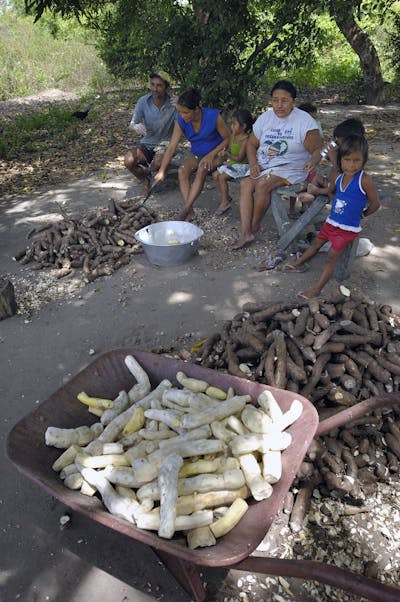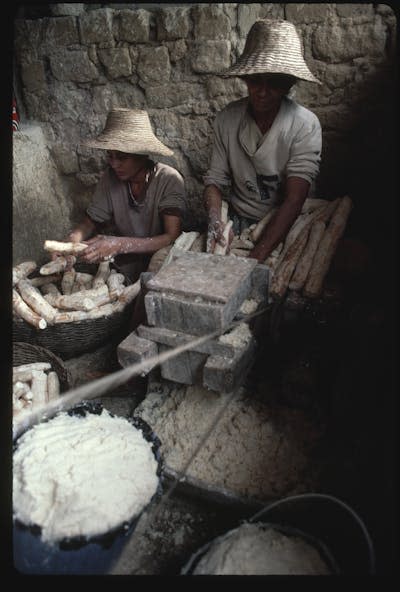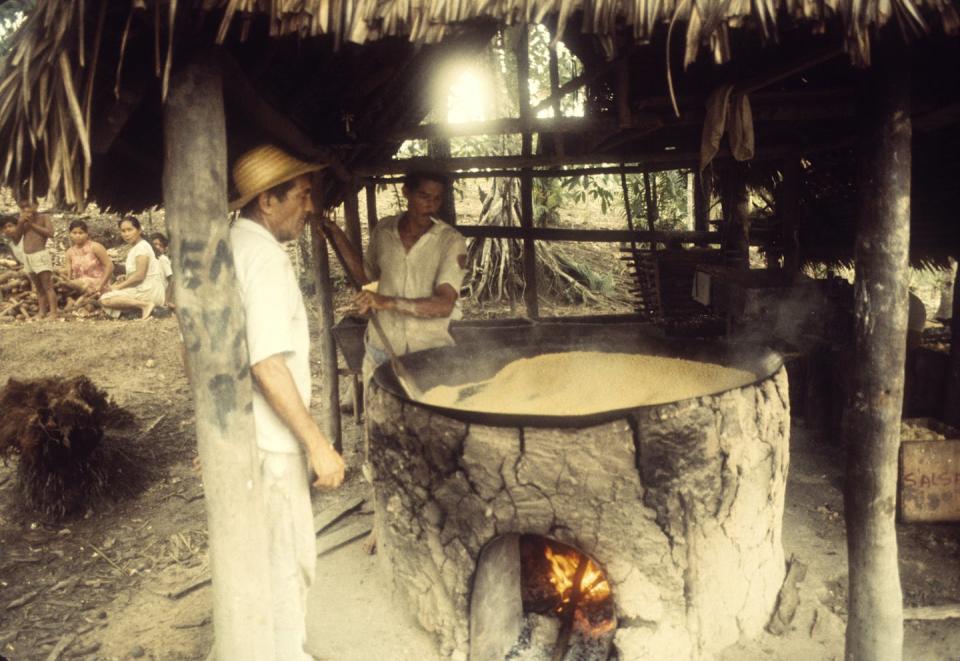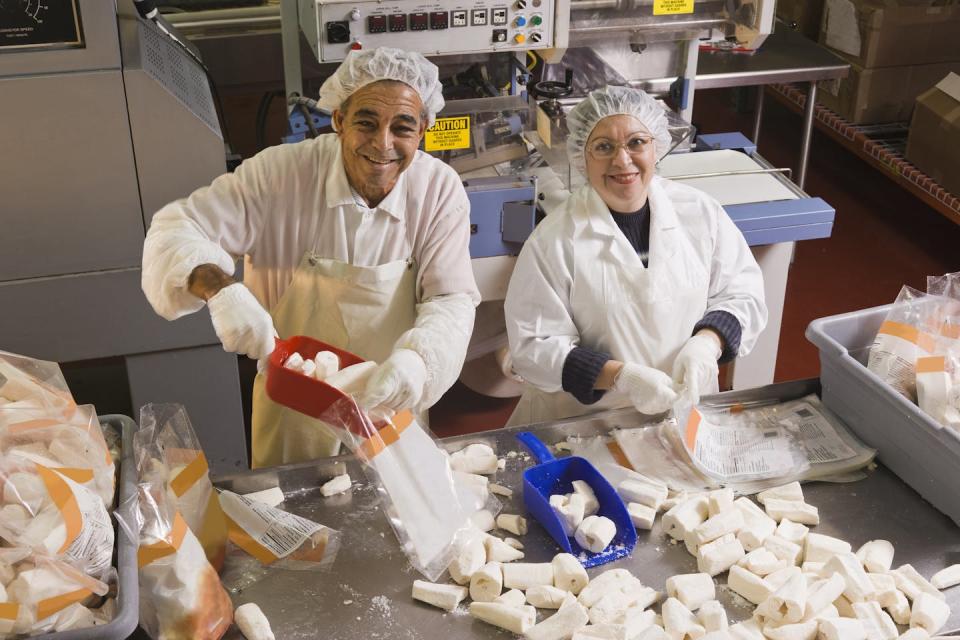Americans are familiar with the three staple crops that dominate modern diets – corn, rice and wheat. However, fourth place is held by a dark horse: cassava.
Although almost unknown in temperate climates, cassava is a staple food source throughout the tropics. It was domesticated 10,000 years ago, on the southern edge of the Amazon basin in Brazil, and spread from there throughout the region. With a scraggly stem a few meters high, a handful of slender branches and moderate, hand-shaped leaves, it doesn’t look like anything special. However, Cassava’s humble appearance belies an impressive combination of productivity, intensity and diversity.

Over thousands of years, the Natives bred it from a weedy wild plant into a crop that stores huge amounts of starch in potato-like tubers, thrives in the poor soils of the Amazon and is virtually invulnerable to pests.
Cassava’s numerous assets seem to make it the ideal crop. But there is a problem: Cassava is very poisonous.
How can cassava be so toxic, but still dominate diets in Amazonia? This is all about Native intelligence. For the past 10 years, my colleague, César Peña, and I have been studying cassava gardens on the Amazon River and its many tributaries in Peru. We have discovered scores of varieties of cassava, growers using sophisticated breeding strategies to manage its toxicity, and elaborate methods to process its dangerous but nutritious products.
A long history of plant domestication
One of the most significant challenges early humans faced was getting enough to eat. Our ancient ancestors relied on hunting and gathering, catching prey and gathering edible plants at every opportunity. They were really good at it. So much so that their populations increased, leaving the birthplace of humanity in Africa 60,000 years ago.
However, there was room for improvement. Searching the landscape for food burns calories, the resource being sought. This paradox forced the hunter-gatherers to make a trade-off: burn calories searching for food or conserve calories by staying at home. The trade-off was almost insurmountable, but people found a way.
A little more than 10,000 years ago, they cleared the hurdle with one of the most transformative innovations in history: the domestication of plants and animals. People discovered that there was no need to hunt for them anymore when plants and animals were used. And they could be selectively bred, producing larger fruits and seeds and bulkier muscles to eat.
Cassava was the famous domesticated plant in the neotropics. After its initial domestication, it spread through the region, reaching sites as far north as Panama within a few thousand years. The growth of cassava did not completely eliminate the need for people to search the forest for food, but it lightened the burden, providing an abundant and reliable food supply close to home.
Today, almost every rural family throughout the Amazon has a garden. Visit any household and you’ll find cassava roasting over the fire, toasting into a chewy flatbread called casabe, fermenting into beer called masato, and steaming into soups and stews. Before adopting cassava in these roles, however, people had to figure out how to deal with its toxicity.
Process a poisonous plant
A powerful defense system provides one of cassava’s most important strengths, its resistance to pests. The system relies on two chemicals produced by the plant, linamarin and linamarase.
These protective chemicals are found within cells throughout the leaves, stems and tubers of the cassava plant, where they normally sit dormant. However, when cassava cells are damaged, by chewing or crushing, for example, the linamarin and linamarase react, releasing a burst of harmful chemicals.
One of them is notorious: cyanide gas. The explosion also contains other nasty substances, including compounds called nitriles and cyanohydrins. Large doses are fatal, and chronic exposures cause permanent damage to the nervous system. Together, these poisons deter herbivores so well that cassava is virtually impervious to pests.
No one knows how humans first cracked the problem, but the ancient Ammonites devised a complex, multi-step detoxification process that transforms cassava from edible to delicious.


It starts with grinding starchy cassava roots on boards shredded with fish teeth, rock chips or, more often today, a rough sheet of tin. Stripping mimics pest chewing, which causes the root to release cyanide and cyanohydrin. But they go into the air, not into the lungs and stomach like when they eat.
Next, the shredded cassava is placed in rinse baskets where it is washed, pressed by hand and drained several times. The action of the water releases more cyanide, nitrile and cyanohydrin, and washes them away due to growth.
Finally, the resulting pulp can be dried, which detoxifies it further, or boiled, which completes the process using heat. These steps are so effective that they are still used throughout the Amazon today, thousands of years after they were first invented.


A power crop is about to spread
Amazonians’ traditional methods of grinding, rinsing and cooking are a sophisticated and efficient method of turning a poisonous plant into a meal. However, the Ammonites pushed their efforts even further, putting it into true domestication. As well as inventing new methods for processing cassava, they began to observe and selectively grow varieties with desirable characteristics, gradually producing a constellation of varieties used for different purposes.
During our travels, we have found more than 70 different types of cassava that are very diverse, both physically and nutritionally. They include toxic varieties, some that require laborious shredding and rinsing and others that can be cooked as is, although none can be eaten raw. There are also varieties with different tuber sizes, growth rates, starch production and drought tolerance.
Their diversity is appreciated, and they are often given catchy names. Just as American supermarkets stock apples called Fuji, Golden Delicious and Granny Smith, Amazonian gardens stock cassava called bufeo (dolphin), arpón (harpoon), motelo (turtle) and many others. This creative breeding cemented cassava’s place in Amman’s culture and diets, ensuring its versatility and utility, just as the domestication of corn, rice and wheat cemented their places in cultures elsewhere.
Although cassava has been kept in South and Central America for thousands of years, its story is far from over. In the age of climate change and ongoing efforts towards sustainability, cassava is emerging as a potential global crop. Its durability and resilience make it grow in changing environments, even when soils are poor, and its natural pest resistance reduces the need to protect against industrial pesticides. In addition, although traditional Amazonian methods for cassava detoxification can be slow, they are easy to replicate and speed up with modern machinery.


In addition, the choice of Amazonian growers to maintain different types of cassava makes the Amazon a natural repository for genetic diversity. In modern hands, they can be bred to produce new varieties, suitable for purposes beyond those of Amazonia itself. These advantages encouraged the first export of cassava across South America in the 1500s, and its range quickly spread beyond Africa and tropical Asia. Today, production in nations such as Nigeria and Thailand far outstrips production in South America’s largest producer, Brazil. This success is raising hopes that cassava can become an environmentally friendly source of nutrition for populations around the world.
Although cassava is not yet a household name in the United States, it is on its way. It has long flown under the radar in the form of tapioca, a cassava starch used in pudding and boba tea. It is also hitting the shelves in the snack aisle in the form of cassava chips and the baking aisle in natural gluten-free flour. Raw cassava is also an emerging presence, showing up under the names “yuca” and “manioc” in stores that cater to Latin American, African and Asian populations.
Track some down and give it a try. Supermarket cassava is perfectly safe, and there are many recipes. cassava fritters, cassava fries, cassava cakes … the possibilities of cassava are almost endless.
This article was co-authored by César Rubén Peña.
This article is republished from The Conversation, a non-profit, independent news organization that brings you reliable facts and analysis to help you make sense of our complex world. It was written by Stephen Wooding, University of California, Merced
Read more:
Stephen Wooding receives funding from Project Amazonas, a non-profit organization that supports humanitarian and research projects in the Peruvian Amazon.